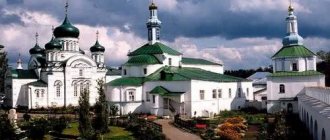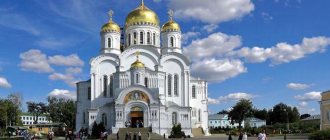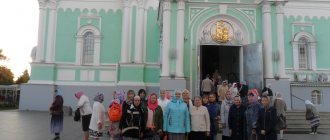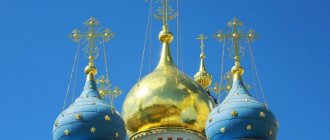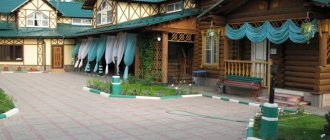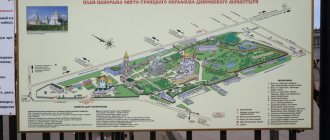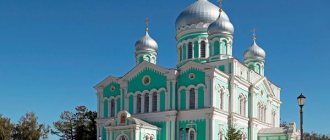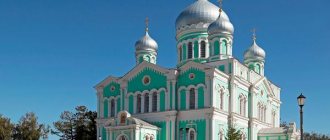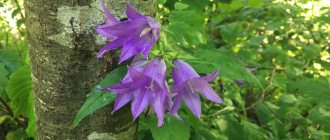The famous Seraphim-Diveevsky convent is located 180 kilometers northwest of Nizhny Novgorod. In the Orthodox world, it is considered the fourth in importance, second only to Iberia, Athos and the Kiev Pechersk Lavra. For many centuries it has been a center of spiritual life in the region, and the names of many Russian saints are associated with it, the most famous and revered of whom is St. Seraphim of Sarov. In addition, the monastery is known for its holy springs.
Miraculous appearance of the icon
Among the holy springs of Diveevo, the oldest is consecrated in honor of the Kazan Icon of the Mother of God and is located not far from the monastery, in the village of Severnoye, separated from the village in which the monastery is located by a ravine, popularly nicknamed Golubin. Next to it stands a wooden parish church bearing the same name as the spring. Once upon a time, in the pre-war years, another temple stood here, but in the wake of one of the many anti-religious campaigns, it was destroyed.
All the church property in it was plundered, but one ancient icon of the Kazan Mother of God survived. Old-timers said that in 1939 she miraculously appeared on the banks of a spring to one of the local residents. A pious man saved it, and today this shrine is kept in the Holy Trinity Church of the Diveyevo Monastery.
The miraculous properties of holy water
To calm the soul, to heal illnesses, and to cleanse themselves of filth, those who suffer resort to the help of holy water. The physical, chemical and biological properties of the simplest and most inexplicable compound of hydrogen and oxygen on earth have not yet been fully studied. Meanwhile, the experience of generations confidently speaks in favor of holy water, which will help in incredible ways in any life circumstances.
An adult entrusts his problems to water if he believes in its power. Even non-believers unknowingly resort to the help of ordinary water, washing away the troubles of the day in the shower. Water relaxes and refreshes, and is often the first remedy for relieving fatigue and drowsiness. Scientists have proven that holy water has a special structure of molecules, their action is aimed at well-being and health promotion, normalization of a person’s emotional and spiritual background, and harmonization of the space around him. Perhaps even before such discoveries, people knew the effect of holy water, but they did not require explanation.
Many people add holy water to the bathtub for bathing babies so that children sleep soundly and more peacefully, and the “strongest” water also helps little children against the evil eye. Holy water is known as a remedy for healing spiritual and physical illnesses; believers often drink a few sips from the silver vats in which the water is stored in temples. The rite of Baptism includes immersion in holy water or at least washing with it, not only symbolizing cleansing from sins, but also performing the sacrament of improving energy.
And people have long noticed the strongest healing effect of water from holy springs. Orthodox believers turn to them when they feel a decline in vital and physical strength, when doubts gnaw at the soul and spiritual strength is running out. But the glory of the sources that help overcome bodily infirmities speaks for itself.
And those in need rush to them with hope and faith, entrusting their bodies and thoughts to the water.
The source of the revived monastery
When the monastery was revived in 1991 after the spiritual desolation that gripped the country during the period of communist rule, a previously destroyed church with a chapel was re-erected next to the source, and a bathhouse was built in it for pilgrims wishing to plunge into the fertile waters.
Twice a year ─ on the feast of the Kazan Icon of the Mother of God and on the Epiphany of the Lord ─ a religious procession is directed to the source, and its waters are blessed. Every year thousands of pilgrims come here not only from all over Russia, but also from abroad. This is not surprising, since there is many evidence of miraculous healings sent down to people who washed themselves with its holy waters.
Some rules
In the territory of spring, it is not customary to speak loudly and disturb believers, swear and behave freely.
Women are better off diving into their shirt. There are kiosks in front of the spring where you can buy swim shirts and water tanks.
In the chapel you can light candles and pray in front of the icon. He will be a psychic before diving in to read the akathist to the Sarov Seraphim and ask him for help.
In the spring, they immerse themselves in water three times, making the sign of the cross. They also drink water with prayer. We must remember that holy water requires reverence and prayer from us, and only then, according to our faith, will it bring us spiritual and physical benefits. Also bring the water that you bring with you from here to the house of worship, a little every day.
On the feast of the discovery of the relics of Seraphim of Sarov on August 1 and on the Epiphany of the Lord, a religious procession is held over the source of Seraphim. Anyone is welcome to join us, pray in the prayer service and see the blessing of the water. And this significant event will be remembered for a long time.
Mother Alexandra's Source
Another nearby holy spring is also surrounded by universal veneration. In Diveevo, or rather, a few kilometers from the village bearing this name, the Vichkinza River flows, and during the spring flood it floods the surrounding meadows with its waters. In its floodplain there is a source, which, according to local belief, flows from the grave of the founder and first abbess of the monastery, the Venerable Alexandra Diveevskaya. This pious nun (in the world Agafya Semyonovna Melgunova), having become a widow at an early age and deciding to devote her life to God, was granted a vision of the Most Holy Theotokos, who showed her the location of the foundation of the future monastery.
Pilgrimages to this source did not stop even during the years of strict anti-religious policies pursued by the government. Despite numerous obstacles created by the authorities, believers secretly visited this place and were washed by the blessed waters.
In 2003, when the Orthodox world celebrated the 100th anniversary of the canonization of St. Seraphim of Sarov, and Diveevo turned into a center of religious celebrations for several months, a chapel was erected over the source, and a bathhouse was equipped for the convenience of pilgrims. According to tradition, three processions of the cross are held annually to this source, which bears the name of Mother Alexandra: on the day of Pentecost, on the feast of the icon of the Mother of God “Life-Giving Spring,” and also on the Epiphany of the Lord.
The healing power of Diveyevo springs
In the main cathedral of the Diveyevo monastery rest the relics of St. Seraphim and there is an image of the Mother of God “Tenderness”. It was in front of her, according to legend, that the Monk Seraphim prayed and died all his life; Tsar Nicholas II, who visited the monastery, kissed her. There are many golden crosses hanging on the icon - gifts from healed pilgrims. Thousands of pilgrims come to the Diveevo Monastery to see the sights of Diveevo , venerate the holy relics and bathe in the life-giving springs. The queues for them in the summer and on church holidays last for several hours.
When bathing in holy springs, especially the distant one - Serafimovsky, worshipers receive healing from colds, radiculitis, long-term bleeding, heart and eye diseases.
The good fame of the Diveyevo springs has long spread throughout Russia. The water from these springs has miraculous powers, the Grace of God is in them.
It is enough to visit one or another source, drink from it or take a dip, and a person will immediately feel physical and mental relief. Local keys relieve pain in those suffering and instill confidence in getting rid of the disease.
Water collected from Diveyevo springs is stored for years and remains fresh, miraculous, as if it had just been taken from a spring.
Mysterious manifestations of spiritual properties have been observed over the springs many times over the centuries. There are many stories and legends among the people that are based on actual facts and are passed on from generation to generation. Let's talk about some of the holy springs of Diveevo.
Source of St. Seraphim of Sarov
The most famous among the Diveyevo springs in our time is the spring on the banks of the Satis River, near the village of Tsyganovka near the Khitryi farm. But, strictly speaking, this is not the Diveyevo, but the Sarov source, since it is located in the Sarov Forest, consecrated by the spiritual exploits of the Monk Seraphim. Now the glory of Sarov passed to Diveevo, and in a similar way this source, together with Satissky, began to be attributed to the Diveevo circle of sources.
The history of the holy spring of St. Seraphim of Sarov is as follows. An old man in a white robe appeared to a soldier serving on the border of a protected zone in the forest near Sarov. To the question: “Old man, what are you doing here?” - he hit the ground with his staff, and in this place a cool spring struck. This happened in the 60s of the 20th century on the banks of the Satis River. So Father Seraphim moved his source from Sarov to the village of Tsyganovka, accessible to all believers.
Later it was decided to fill up this spring. They brought the tractor, but the engine stalled. While we were going to pick up the broken part, an old man appeared to the tractor driver and said: “Vasily, don’t fill up my source.” And no matter how much they cursed, no matter how much they tried to persuade Vasily, he flatly refused to do it. The boss who ordered the source to be filled up was soon transferred to another job.
In 1995, the course of the Satis River was changed, and the spring formed an entire lake. They built a chapel on it, installed a well, and paved the access road. Many people come here for healing water, seeking help from Father Seraphim. The holiness of the source is evidenced by many cases of miraculous healings.
Mother Alexandra's Source
This is the spring closest to the monastery. On Epiphany, on the feast of the icon of the Mother of God "Life-Giving Spring", Mid-Pentecost and other holidays, religious processions are held here and the water is blessed. There are known cases of healing after bathing in this spring. Previously there was a fontanel in which children bathed. After the construction of the dam in the early 60s and the flooding of the ancient Near Spring of Mother Alexandra, its name was transferred to this small spring. Now if you look for the Alexander Spring, you will be pointed to this spring.
According to the testimony of the sisters of the first community who lived at the Kazan Church, at the grave of Mother Alexandra they saw fire and burning candles at night, heard an extraordinary ringing, and some felt an extraordinary fragrance emanating from her grave. Then some kind of murmur was heard in the grave, and therefore the people believed that the key that opened under the mountain came from the grave of Mother Alexandra. This spring flowed near the river behind the road, opposite the Kazan Church. When a dam was built in Soviet times, the reservoir covered the spring. Down the river in the southwest they consecrated another spring, where they now collect healing water.
Kazan Source
The Kazan spring is located in Diveevo, on the outskirts of the village, behind the Golubin ravine near the village of Severny, next to the Kazan wooden parish church.
It is believed that this is the oldest of the revered sources in Diveevo and dates back to the time of Murza Diveya, who owned these places in the 16th century.
In 1845, a chapel already stood on the site of the spring, which can be seen on the land plan of that time. It was made of wood and was rebuilt and updated several times. Local residents supported it until 1939, when it was destroyed by the Soviet authorities. In the middle of the 20th century, the sanctuary was restored for a short time, only to be destroyed again.
According to the descriptions, the last chapel was high, with many faces on the walls. In its center there was a log house-source. Moisture flowed out of the chapel through a gutter installed in the log house. Here they bathed sick children, filled buckets and doused themselves. When the chapel was destroyed, the icons were scattered across the field. Even before this incident, in 1933, a local resident found the Kazan Icon of the Mother of God frozen in ice near a spring. The image is placed in the Trinity Cathedral in the chapel in honor of the Icon of the Mother of God “Tenderness”.
In 1991, a chapel and bathhouse were erected over the Kazan spring in Diveevo, which were then rebuilt again in 1997. The Sacrament of Baptism is often performed in the waters of the spring, due to its proximity to the Kazan wooden church.
Next to the Kazan spring there is a spring of the holy great martyr and healer Panteleimon.
Iversky Source
Along the path along the river you can reach the distant spring of Mother Alexandra. The Great Eldress herself dug it to quench the thirst of the workers who were extracting limestone for the Kazan Church she was building.
According to legend, local residents prayed at the spring during a drought for rain. The people considered this spring to be healing and brought sick children to bathe in it. In the 19th century, a chapel was built there. Based on the icon of the Iveron Mother of God that was in it, the source was named “Iveron”.
The miraculous appearance of the old man
It is known that in Soviet times this spring was located in the city of Sarov, and it was there that numerous pilgrims went. But at the end of the 50s, a certain military facility was located in the city, and it became inaccessible to visitors. And then a miracle happened. One day in 1961, a soldier guarding the forbidden zone witnessed how an old man in a shabby cassock appeared out of nowhere and struck the ground three times with his staff, and a spring immediately gushed out of it.
No matter how hard the authorities tried to put him to sleep, nothing worked. As soon as the bulldozer approached the clear and clean stream of water gushing out of the ground, the engine stalled on its own and did not want to start. Finally, the old man in a cassock appeared again, this time to the bulldozer operator himself, and ordered him to stop trying to fill up the source. Needless to say, this elder, who appeared in a vision to two completely different people, was the Venerable Father Seraphim. It was he who moved his blessed source to a place accessible to pilgrims.
In post-perestroika times, a lake filled with clean spring water gushing from underground was excavated at this place, and baths were equipped. The Sarovsky Spring in Diveevo (as it is usually called not by its location, but by its affiliation with the monastery) is visited annually by hundreds of thousands of pilgrims. The sisters of the monastery keep a special book, which documents cases of miraculous healings sent down to the suffering after their ablution in the waters of the miraculous spring.
Source of St. Seraphim
Even during his lifetime, Saint Seraphim helped people if doctors and medicines were powerless. Among the frequent stories about those who were helped by the source are cases of people suffering from nervous diseases, memory disorders and epileptic seizures.
There is a legend or true story about how in this place, located in forbidden territories in the sixties, while border guards were walking around the fenced area of Sarov, they had a vision. In the pre-war years, the source existed, but they repeatedly tried to cement it or bury it. In 1947, a military installation designated the area as closed, and the wasteland was deserted. Therefore, the military were surprised when they noticed the figure of an old man in a white robe with a staff, and, calling out to him, they saw how the old man hit the ground with his staff three times and disappeared. At this point a spring began to flow from three points. In the sixties, the spring gained fame; water from it was transported to all parts of Russia. They also came here to swim in it. In the early nineties, the military decided to fill up the source. However, during the preparatory work, the Monk Seraphim appeared to the excavator driver, asking him not to do this, and finally said that this would not happen anyway. And indeed, the soil did not give in to the excavator’s bucket, and the source was preserved.
Subsequently, the order was canceled, then the Diveevo Monastery was restored, and today the source of Seraphim of Sarov is listed under its jurisdiction, and a log chapel was built near it.
They say that even during the restoration work to strengthen the stream bank line for the safety of those suffering, there was one worker who injured his back. The appearance of Seraphim of Sarov healed him. Today people flock here for healing of physical ailments. Bathing in a spring, or at least ablution, must certainly be accompanied by a certain mood, prayer from a pure heart.
History of the Source of the Mother of God
Diveevo is also famous for the spring gushing out of the ground, the history of which dates back to the second half of the 17th century, when an uprising broke out in Rus' under the leadership of Stepan Razin. Legend has it that on October 9, 1670, on the eve of the decisive battle between the tsarist troops and rebel detachments, the water in the spring flowing from the ground 12 kilometers from Diveyevo suddenly became blood red, and the face of the Mother of God was clearly visible in it, shedding tears for those who were to die in the upcoming battle. From that time on, the source began to enjoy nationwide veneration and was called “Revealed.”
However, the miracles associated with him did not end there. Already in the 19th century, the Venerable Seraphim of Sarov, providing spiritual guidance to the sisters of the monastery, told them that he had witnessed how the Most Holy Theotokos washed Her most pure face in the spring before walking along the path along which the famous Holy Kanavka was later excavated, which fenced the monastery with an impenetrable a barrier from evil spirits.
It should also be noted that among other sources in Diveevo, it is one of not only the oldest, but also the most revered. It is known that in 1903 he was visited by Emperor Nicholas II, who arrived for the celebrations dedicated to the canonization of St. Seraphim of Sarov. In memory of his arrival, a silver icon of the newly glorified saint, donated by him, was kept in the monastery for many years. Nowadays the source is equipped with a bathhouse, and a chapel has been erected next to it.
Rules for visiting the groove of the Blessed Virgin Mary in Diveevo
Among the Orthodox, the Canal of the Blessed Virgin Mary is revered as one of the great shrines of the Christian world. But unlike other shrines, Kanavka has its own special properties that set it apart from the host of other objects of worship. Prayer icons, relics of holy saints and even huge churches can be moved, and the Mother of God Kanavka is forever tied to Diveevo, because it is associated with a miraculous phenomenon.
As the Monk Seraphim of Sarov described, the Most Holy Theotokos appeared to him and walked along the earth with him, marking the place where the Mill Maiden Community was founded. “The feet of the Most Pure Mother of God walked on the sinful earth in this place” - with these words the great elder Seraphim of Sarov characterized this place.
Reasonable restrictions
There are concepts and rules that are not stated anywhere, but as St. wrote. Apostle Paul: “written on tables of flesh of the heart” (2 Cor 3:3). Any person, with sober reasoning, has boundaries and limits of what is permissible. These categories are absorbed with mother's milk and should guide people throughout their lives. The rule for visiting the Mother of God Canal is based on these grounds.
As a reminder for heterodox and unchurched tourists, these rules are set out in the form of recommendations in leaflets for guests of hotel complexes, for example, “Diveevskaya Sloboda”. There is nothing complicated in these recommendations, they are very similar to the requirements that everyone observes when visiting the “Tomb of the Unknown Soldier” at the Kremlin Wall, or entering Red Square:
- Keep quiet;
- Not to run;
- Be neatly dressed in clean clothes;
- Don't smoke and be sober, etc.
In general, these are the usual rules of decent behavior for a well-mannered person. But if in secular places law enforcement agencies monitor order, and in case of repeated violation of the peace they can take legal measures, then in holy places there is a fundamentally different approach. In the Epistle to the Galatians, the Apostle Paul (6:7) directly says: “Do not be deceived: God cannot be mocked.”
How to prepare for visiting a shrine
Diveyevo is not just a geographical object, but a place where for many centuries, millions of Orthodox people offered their prayers to God. The area itself encourages pilgrims and tourists to observe pious traditions and rules. If you do not resist the dictates of your heart, then a person organically fits into these criteria, and your stay in Diveevo passes without misunderstandings.
However, before approaching such great shrines as the Canal of the Most Holy Theotokos, it would be very good if a person turns to the Lord in prayer. Even if it is not a prayer from church books, but created from the heart, in your own words. The main thing is that it is a sincere and pure request.
Iversky spring
Continuing the story about the holy springs in Diveevo, it is impossible not to mention one more of them, associated with the name of the founder of the monastery, Reverend Mother Alexandra, who was already mentioned in one of the previous sections of the article. It is located not far from the spring that bears her name.
Tradition says that when in 1774 workers were working to extract limestone for the construction of the Kazan Church on the territory of the monastery, mother with her own hands dug a spring in the ground from which they quenched their thirst. Later, pilgrims who came to the monastery, among whom there were many women with young children, began to take water from it. And so, it was noticed that as soon as the child was washed with water from the source, his illnesses and infirmities immediately receded.
Thanks to such miraculous properties, believers from all over Russia began to come to the source, bringing sick children with them. Over time, a chapel was erected nearby, consecrated in honor of the Iveron Icon of the Mother of God, in front of which since ancient times it was customary to offer prayers for the health of ailing youths and young women. Nowadays, for the convenience of pilgrims, the source is equipped with a bath.
Our trip to the spring of Seraphim of Sarov
From Diveevo, since we were somewhat limited in time, we went to only one source, the most distant one - the source of Seraphim of Sarov. We didn’t find any signs in Diveevo itself. Local residents explained the way. True, this explanation was like this: “Go straight, don’t turn anywhere, twelve kilometers.” And when, on the way out of Diveevo, we came across a T-shaped intersection, we stopped in indecision. A tractor was working nearby, and we asked the tractor driver where to go. Apparently, we were not the first to ask this question, because the tractor driver just tiredly waved his hand in one direction and muttered: “to the right.”
After traveling some distance, I doubted whether I was going there. Near a village where there was a small car service station, we stopped to ask for directions. In response to my question whether we were going there, the guy from the car service pointed to a sign on a pole, which he personally attached and which I did not notice: “Straight to the source.” But he explained the route to us in detail. It turned out that there would be a crossroads almost at the end. You need to cross it, but let all the cars pass on the right, where the main road goes. Drive through the construction market, further in the forest there will be monasteries. The road itself will lead to the source. After thanking the kind man, we set off. By the way, the navigator that I connected was glitching all the time and was disconnected from power. Either the proximity of closed Sarovo had an effect, or Father Seraphim tried.
And now we are at the sources. It is impossible to miss them - there is a huge parking lot for cars and buses nearby, there are a lot of people. We took water cans and went to the source. There were snakes swimming in the river, which meant the water was clean. The source itself is well equipped and has baths. We did not dare to dive into the water - it was too cold. Just washed your face. Water from the springs is first collected into buckets, and then poured into cans and bottles using ladles.
Spring of Seraphim of Sarov near Tsyganovka, house
Source of Seraphim of Sarov near Tsyganovka. The river in which the snakes swam
Source of Seraphim of Sarov near Tsyganovka
Source of Seraphim of Sarov near Tsyganovka
Source of Seraphim of Sarov near Tsyganovka
The sun was setting, and a long road to Murom awaited us. So we hurried on our way.
Source of the healer Panteleimon
Not far from the Kazan spring, mentioned earlier in the article, there is another one, bearing the name of the great healer of the 4th century, the great martyr and healer Panteleimon. The story about him completes our brief overview of the most famous holy springs in Diveevo. It was not by chance that it was recognized as miraculous, and it was not without reason that it was consecrated in honor of the great silver-free doctor.
The reason lies in the healing properties of its water, which became known thanks to the experience and observations of the same pilgrims. Even in Soviet times, stories of those who visited Diveevo and received healing from its waters were passed on from mouth to mouth. It is known for certain that there have been cases of recovery even from those patients whom official medicine was forced to abandon. Despite the fact that its waters especially often bring healing to joint diseases, people suffering from other diseases equally resort to the help of the spring.
How to be healed using holy water from a source
They say that after collecting holy water from a spring, people take it home, store it for years, and it remains as fresh and tasty as if it had just been drawn from a gushing spring. And when preparing preserves for the winter, pickles, and fermentations, such water will ensure long-term storage of products, preventing mold or rotting. Someone tried to explain these properties by the mineral composition of the water, but even minerals are subject to mustiness if not properly sealed, and Diveyevo holy water from the springs remains unchanged for years.
By collecting water with you in some container, metal or glass (the main thing is that it is not plastic), you can take the liquid with you and drink it as needed. You can add this water in small quantities to the bath, drinks and soups during the cooking process.
Based on this miraculous remedy, you can make any drink and give it to all household members as needed; you can also give it to infants. A capricious child can be washed with holy water so that he calms down faster.
Pilgrims about the springs in Diveevo
Reviews of those who, having visited the Diveyevo Convent, washed themselves in the waters of the holy springs surrounding it, can be read both in the guest book, which contains numerous entries from visitors, and on various information resources on relevant topics. Without exaggeration, we can say that the overwhelming majority of pilgrims note the feeling of belonging to the shrine that washed over them at the moment of visiting the springs, which became not only visible to them, but also tangible. This feeling is akin to what people experience when they find themselves in Jerusalem or Mount Athos.
Tales of Miracles
The Chronicle of the Seraphim-Diveevo Monastery describes in detail the lives and miracles of its founders - St. Seraphim and Agafya Melgunova (schema-nun Alexandra).
Agafya Melgunova was a nun when she received a sign from above from the Mother of God, who appeared to her with instructions to go to the Nizhny Novgorod region - her Fourth and last Destiny on Earth. According to the lot cast by the apostles, the Most Pure Mother of God was going to the land of Iveron (the first Destiny), during a sea voyage to the resurrected Saint Lazarus by Jesus, the ship ended up on Mount Athos (the second Destiny of the Mother of God), the third Destiny is considered the Kiev-Pechersk Lavra. And finally, Agafia Semyonovna Melgunova appeared in these lands, guided by the hand of the Mother of God.
The temple erected here was erected by the forces of St. Seraphim at the end of his life. The son of a merchant family, having been healed from an illness in his youth thanks to the miraculous icon of the Mother of God, dedicated himself to God and himself received miraculous power to help heal those in need.
Tales of how the local saints helped people during their lifetime were recorded by their followers and abbots of the monastery. In Diveevo, the springs today continue the good work of those who are now elevated to the ranks of saints.
Holy springs in Diveevo: how to get there
Nowadays, an increasing number of Russian citizens are turning to Orthodoxy, drawing their spiritual strength from it. At the same time, the flow of pilgrims to the monastery located in Diveevo increases every year. There is no point in indicating the addresses of the sources that are the purpose of the trip individually, since all of them, although located at a certain distance from each other, are part of a single monastery complex, and to visit them you should first of all come to the monastery itself, from where the sisters will show the way to each of them.
Monastery address: Nizhny Novgorod region, Diveevo district, village of Diveevo. Having reached Nizhny Novgorod by train or intercity bus, you should continue your journey from the city bus station by a regular bus that goes to the village of Diveevo and departs every 2-3 hours. Despite the fact that the road may seem tiring, at the end of the journey, holy springs in Diveevo await pilgrims, photos of which are presented in the article.
How to get there
There are several ways to get to the source. By personal transport, by regular bus Diveevo - Satis. Unfortunately, regional buses do not stop at the source itself, but stop in the village of Tsyganovka. So you will have to travel 3 km, the road is good, so in the summer many pilgrims choose this route. Sometimes it is useful to take a walk to the source, admiring nature and calming the soul.
Excursion buses run from the Seraphim-Diveevsky Monastery to the source. Along the way you will hear the history of the monastery and on the spot you will have time to pray, immerse yourself in the spring and take the water with you. Check the time of departure to the monastery pilgrimage center by phone: 8 (83134) 4-34-45
How to find Diveevo
The Nizhny Novgorod region is quite confusing for visitors from neighboring countries, so if the region is not familiar to you, then the landmarks are as follows: Diveevo is located 180 km from Nizhny Novgorod, 65 km from Arzamas and 345 km from Cheboksary. If you are planning a trip in your own car, it would be a good idea to use a navigator.
There will be several regional centers along the M-7 highway, where you can find out which side of Diveevo is and how to get to the village. But be prepared for the fact that not the smoothest roads will allow you to travel at a speed of no more than 120-140 km/h. The monastery has well-equipped parking and is free for visitors. There are many hotels in the area, so you can easily stay in Diveevo and count on an overnight stay.
Story
The source was discovered a long time ago, when the Stavropol fortress was built. It is located in the north-west of the city, near the St. John the Mariinsky Monastery. At that time, the clergy began to look after the spring; after the construction of a monastery nearby, its workers did their best to improve the spring. An artificial grotto was built. People treated many diseases with healing water from this spring.
During the October Revolution and the formation of Soviet power, everyone forgot about the source and it became abandoned. Later, an oncology hospital was built in its place, but the healing water still found another way out of the ground and filled up in another place.
In 1998, they remembered about the source, and the city administration allocated money from the budget for its improvement. Since at that time they were celebrating the 240th anniversary of the birth of St. Seraphim of Sarov, it was decided to name the restored source in his honor.
Now a limestone wall with a canopy and a very small shiny dome has been erected around it. Water from the spring flows into a small bathtub, and from it into a special pool.
